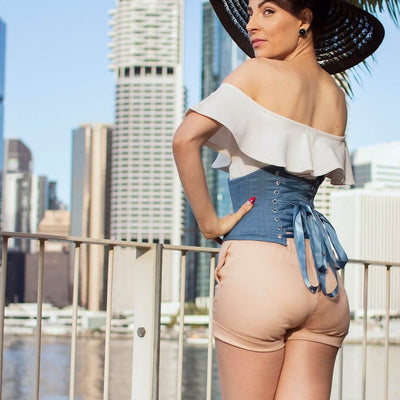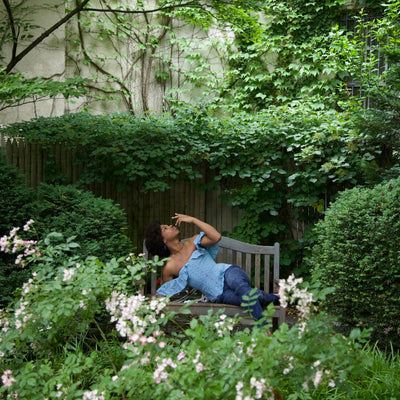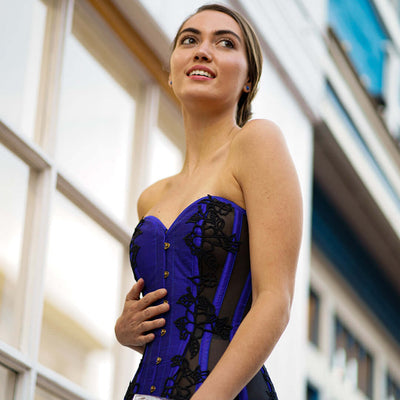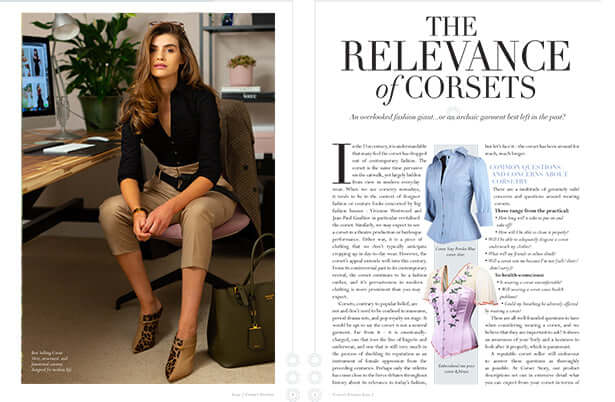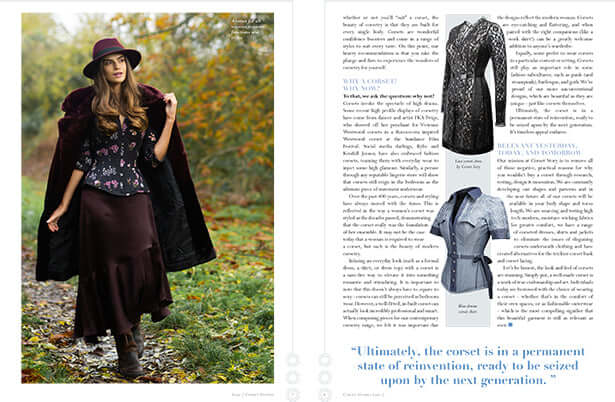The History of Corsets - a journey through the ages
The corset has been around for centuries, though its function and form have changed drastically. In the early days, corsets were designed to help shape the body into a more idealized form, though they often came at the expense of comfort.
Today, corsets are more commonly worn as a fashion statement, though they can still be used to sculpt the body into the desired shape.
The corset has a long and complicated history. The term is short for "corset girdle," a tight-laced, boned garment designed to slim the waist and shape the female figure. The first corsets date back to Ancient Greece, but it wasn't until the Victorian era (specifically 1838) that they became a fashion staple.
In this article, we will discuss the history of corsets, from their origins to their modern-day iterations. So, let's dig in and learn more about the fascinating history of this iconic garment.
The History of Corsets
According to historical records, the Minoans were the first civilization to wear corsets. The Minoans inhabited Crete and lived in the vicinity of Greece around 1000 BC. The earliest picture of a corset comes from a figurine of the Minoan snake goddess, depicted wearing a corset-like garment. Corset-like garments were also found in Minoan artwork, suggesting that both men and women wore them.
The first known corset was made of linen and wool and was found in a tomb in Crete. This corset was likely used for ceremonial purposes rather than everyday wear. The next record of corsets comes from ancient Greece, where they were known as "Zone." These corsets were made of linen or wool and were designed to fit tightly around the waist. They were often decorated with gold or silver threads and featured beading or other embellishments.
However, in the middle ages, the corsets were not needed to highlight the women's figures as the bodies were seen as sinful. Women wear fully covered dresses from head to toe as they prioritize comfort over body shape.

16th Century
As mentioned earlier, corsets were used as undergarments and had their origin in Italy. The corset concept was introduced by Catherine de Medici in France in the 1500s and was accepted by the French court. A corset of this sort was a tight, elongated bodice worn beneath clothing. The ladies of the French court regarded this corset as "essential to the female figure's attractiveness."
By the mid of 16th century, they have commonly worn garments among the women of Europe and Great Britain. A "busk," a long, flat piece of whalebone or wood inserted into the casing of the corset to maintain its rigid form, began to be employed in place of boning. The “stomacher” was a stiff, V-shaped structure worn on the abdomen for ornamental purposes and covered the front of the corset. At the end of the 16th century, ruffles were added to the bottom edge of the stomacher, which became known as a “farthingale.”

17th Century
In the 17th century, corsets were mostly made from bones and linen, including reeds and whalebones. The laces were usually made from hemp or linen thread. In this period, both men and women wore corsets. Corsets were sometimes worn with attached sleeves, and the lacing on them became quite ornamental, some women adding ribbons to give it a little more flair. During this era, the corset had evolved into a fabric bodice secured over a deeply boned core.
A long, pointed busk was in the front of the corset, and it would have laced in the back. There are records of health problems among young girls who began to "tight lace" to follow fashion. Later on, dresses were boned, suggesting that women donned corsets together with a boned dress.
18th Century
The 18th century saw another cinched form take hold and an even more constricting shape. The corset was made of hard material in the 1800s, with rows of stitching that encased whalebone, cane, or hemp-like materials tightly. It was long-waisted and had a cut with a narrow back, wide front, and shoulder straps. If we talk about its design, the look was achieved by stiffening the bodice with boning and lacing it tightly.
The corset of this era was designed to make the waist appear smaller compared to the hips. This was done by forcing the floating ribs down and compressing the stomach. For this reason, corsets of this era were also known as “stays.” They were generally made from linen, cotton, or wool and formed by making several cuts from the lower edge to the waistband. It spreads when the women wear and provide more comfort and room to their hips.
The corsets were frequently lavishly adorned, with finely stitched tunnels for boning, precious silk brocade, and gold trimmings.
It may seem odd to people living in the 21st century that busters were used for several years before becoming fashionable in recent times, dating back to the late 18th century when women's waistlines began to rise.
By the mid-nineteenth century, the corset had primarily evolved into a breast support system. The waist was brought just below the bustline.

19th Century
According to history, Corsets reached their zenith during the Victorian era. The waistline was returned to its natural position in the 1830s to serve the core purpose. In addition, it served the dual purpose of supporting the waist and breast.
The hourglass silhouette was in vogue, and corsets were designed to achieve that look. They were boned with whalebone, steel, or reed, and the lacing was used to tighten the corset. The front of the corset was flat, and the back was curved. Corsets were often decorated with frills, lace, and bows.
The Victorian corset was designed to make the waist look smaller than the hips. This was done by forcing the floating ribs down and compressing the stomach. The corset was often lavishly adorned, with finely stitched tunnels for boning, precious silk brocade, and gold trimmings.
A Frenchman named Jean Werly created a loom-made corset for ladies in 1839. This style remained quite popular until 1890, when machine-made corsets became more fashionable and popular. All previous types of corsets were handcrafted previously - and, usually, at home.

The Edwardian Corset (1900-1915)
The early 20th century returned a more natural look, with a low, narrow waistline. The corset was designed to support the bust and create a slim silhouette.
The corset was less constricting than its predecessor, and a more natural look replaced the hourglass silhouette. The corset was often decorated with frills, lace, and bows.
The Flapper Corset (1920-1930)
The flapper corset was a shorter, less constricting corset popular in the 1920s.
This corset was designed to do the exact opposite of all of its predecessors through the ages. The look of the tiny waist and hourglass figure was gone and the more rectangular, straight look was adopted in women's fashion. If you were a curvy woman of the 1920's then undergarments were used to achieve the new straight-line look. This look was achieved by stiffening the bodice with boning and lacing it tightly.

Post World War I
During WWI, the corset fell out of fashion, and women began to wear more relaxed clothing. Also, women were asked not to wear corsets so that the metal could be used for war weapon production.
This step liberated around 28,000 tons of metal which is enough to build 2 battleships.
Women's roles in society also altered due to economic changes after World War I.
A young woman would typically begin wearing a corset at about 15 and stay at home until she was about 18 years old during the early part of the 20th century.
More young women wanted education after the war, and in the West, courtship was delayed until they were in their early to late twenties. Only overweight or pregnant females may wear a corset, usually an under-bust version.
However, these garments were more commonly known as girdles designed to reduce the hips in size. A resurgence of waist nipping corsets in 1939 caused a stir among fashionistas, but World War II put an end to their comeback.
Originally worn as undergarments, Corsets began to be worn again in the 1990s and have since made a remarkable comeback.
The corset has seen a resurgence in fashion since 2010. Corsets are presently gaining popularity as both outerwear and lingerie.

The Modern Corset (21st Century)
The modern corset is a shorter, less constricting corset popular in the 21st century. The look is achieved by stiffening the bodice with boning and lacing it tightly. The corset is often decorated with frills, lace, and bows.
These corsets are made by combining modern technology to reach the desired shape and look while still providing the wearer with support, comfort, and style.
The modern corset has seen a resurgence in fashion since 2010 and they are presently gaining popularity as both outerwear and lingerie.
Also, corset dresses, tops, and corsets with shoulder straps are becoming popular as outerwear. They are available in a variety of styles, sizes, and colors. They can be made from various materials, including leather, PVC, satin, and denim.
Are you looking for corset outfit ideas? Check out our corset collection, including tops, shirts, waspies, and more.
Well, that’s all about the history of corsets and their evolution. We hope you enjoyed reading this post. Stay tuned for more such informative posts in the future. Also, feel free to contact us at sales@corset-story.com for a corsetry style guide!

